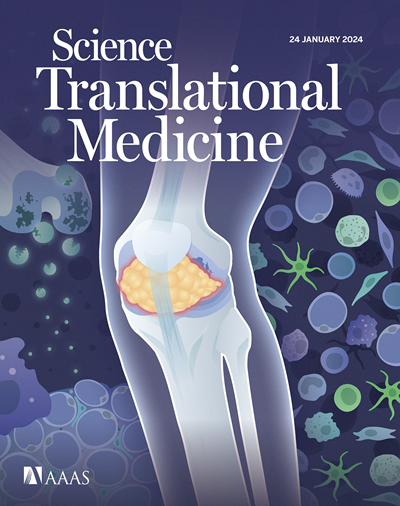Gluconolactone restores immune regulation and alleviates skin inflammation in lupus-prone mice and in patients with cutaneous lupus
IF 15.8
1区 医学
Q1 CELL BIOLOGY
引用次数: 0
Abstract
Systemic lupus erythematosus (SLE) is characterized by dysfunctional regulatory T cells (T葡萄糖酸内酯在狼疮易感小鼠和皮肤狼疮患者中恢复免疫调节和减轻皮肤炎症
系统性红斑狼疮(SLE)以调节性T细胞(T regs)功能失调为特征。我们之前的研究表明,蛋白磷酸酶2A (PP2A)在维持T regs的抑制功能中起着关键作用。在这里,我们分析了来自PP2A野生型和PP2A缺陷T regs的磷蛋白质组学和代谢组学数据,并证明PP2A通过戊糖磷酸途径(PPP)调节T regg功能。此外,我们证明了PPP代谢物葡萄糖酸内酯(GDL)通过促进叉头盒蛋白3和磷酸化信号换能器和转录激活因子5的表达,抑制T辅助性T 17 (th17)在小鼠细胞中的分化,从而增强体外诱导的(i)T reg分化和功能。在吡喹莫德诱导的小鼠短期自身免疫中,GDL治疗通过抑制th17细胞来减轻炎症。GDL促进T regs功能,减轻MRL中的皮肤病变。LPR狼疮易感小鼠体内实验。在SLE患者的体外实验中,它还能促进T regs的分化和功能。最后,在患有皮肤红斑狼疮的患者中,局部应用含有gdl的乳膏可以控制皮肤炎症,并在2周内改善皮肤病变的临床和组织学外观。总之,我们已经确定GDL是PPP代谢物,并在机制上表明,它通过诱导T抑制功能和抑制T h17细胞,在体外和体内恢复免疫调节。GDL可作为炎症性和自身免疫性疾病的一种治疗方法。
本文章由计算机程序翻译,如有差异,请以英文原文为准。
求助全文
约1分钟内获得全文
求助全文
来源期刊

Science Translational Medicine
CELL BIOLOGY-MEDICINE, RESEARCH & EXPERIMENTAL
CiteScore
26.70
自引率
1.20%
发文量
309
审稿时长
1.7 months
期刊介绍:
Science Translational Medicine is an online journal that focuses on publishing research at the intersection of science, engineering, and medicine. The goal of the journal is to promote human health by providing a platform for researchers from various disciplines to communicate their latest advancements in biomedical, translational, and clinical research.
The journal aims to address the slow translation of scientific knowledge into effective treatments and health measures. It publishes articles that fill the knowledge gaps between preclinical research and medical applications, with a focus on accelerating the translation of knowledge into new ways of preventing, diagnosing, and treating human diseases.
The scope of Science Translational Medicine includes various areas such as cardiovascular disease, immunology/vaccines, metabolism/diabetes/obesity, neuroscience/neurology/psychiatry, cancer, infectious diseases, policy, behavior, bioengineering, chemical genomics/drug discovery, imaging, applied physical sciences, medical nanotechnology, drug delivery, biomarkers, gene therapy/regenerative medicine, toxicology and pharmacokinetics, data mining, cell culture, animal and human studies, medical informatics, and other interdisciplinary approaches to medicine.
The target audience of the journal includes researchers and management in academia, government, and the biotechnology and pharmaceutical industries. It is also relevant to physician scientists, regulators, policy makers, investors, business developers, and funding agencies.
 求助内容:
求助内容: 应助结果提醒方式:
应助结果提醒方式:


